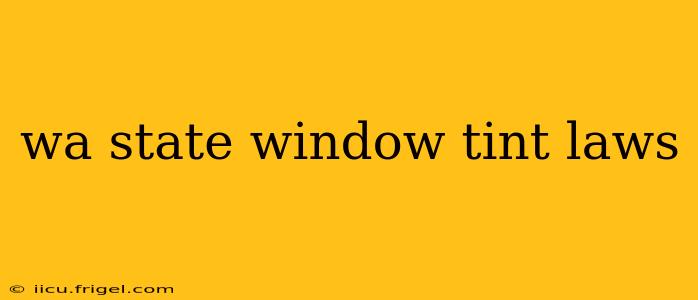Washington State has specific regulations regarding window tinting on vehicles, ensuring both driver safety and visibility. Understanding these laws is crucial to avoid penalties. This guide provides a comprehensive overview of Washington's window tint laws, addressing common questions and clarifying legal requirements.
What are the legal tint percentages in Washington State?
Washington State law doesn't specify tint percentages directly, but rather focuses on light transmission. The law requires that the front side windows (driver and passenger) allow at least 24% of light to pass through. All other windows (rear side windows and rear windshield) have no minimum light transmission requirement, but there are restrictions on the type of tint allowed. Remember that these percentages refer to visible light transmission (VLT).
Can I have window tint on my rear windshield in Washington?
Yes, you can have tint on your rear windshield in Washington, provided it meets specific requirements. While there's no minimum VLT percentage for the rear windshield, you must have properly functioning rearview mirrors and/or defoggers. This is crucial for maintaining adequate visibility.
What about the rear side windows in Washington?
The rear side windows in Washington also have no minimum VLT requirement. However, any tint applied must not obstruct the driver's view.
Are there any exceptions to Washington's window tint laws?
Yes, there are some exceptions. Vehicles used for commercial purposes may have different requirements, and law enforcement vehicles are often exempt. Additionally, medical exemptions may apply in certain cases, requiring appropriate documentation. It's always best to consult with the Department of Licensing (DOL) to confirm whether an exception applies to your specific circumstances.
What are the penalties for violating Washington's window tint laws?
Violating Washington's window tint laws can result in a traffic ticket and fines. The specific amount of the fine can vary depending on the severity of the violation. In addition to the fine, you may be required to remove the illegal tint.
How is window tint measured in Washington?
Law enforcement typically uses a device called a tint meter to measure the light transmission of your vehicle's windows. This meter accurately determines the percentage of light passing through the tint.
Where can I find more information about Washington's window tint laws?
The most reliable source of information is the Washington State Department of Licensing (DOL) website. They have official publications and resources that clearly outline all legal requirements. You can also contact your local Department of Licensing office directly for clarification or further assistance.
What types of tint are allowed in Washington?
Washington law focuses on light transmission, not the type of tint. Therefore, the type of tint material itself is not explicitly regulated, as long as it meets the minimum light transmission requirements. However, certain types of tint might be more likely to meet the legal requirements than others.
Can I get a medical exemption for window tint in Washington?
Yes, it's possible to obtain a medical exemption for window tint in Washington State. This typically requires a doctor's certification verifying a medical necessity for reduced light transmission. The specific documentation needed and process for obtaining the exemption should be clarified with the Department of Licensing.
This guide provides a general overview of Washington State window tint laws. For the most accurate and up-to-date information, always consult official sources like the Washington State Department of Licensing website. Following these laws ensures compliance and prevents legal issues. Remember, safety and visibility are paramount when it comes to vehicle window tinting.
